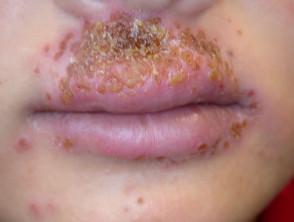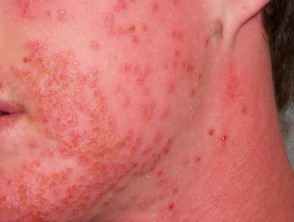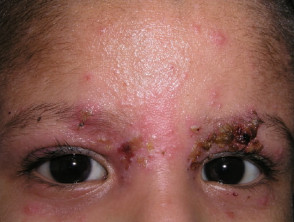What is eczema herpeticum?
Eczema herpeticum is a disseminated viral infection characterised by fever and clusters of itchy blisters or punched-out erosions. It is most often seen as a complication of atopic dermatitis/eczema.
Eczema herpeticum is also known as Kaposi varicelliform eruption because it was initially described by Kaposi in 1887, who thought it resembled chickenpox/varicella.
What is the cause of eczema herpeticum?
Most cases of eczema herpeticum are due to Herpes simplex type 1 or 2.
Eczema herpeticum usually arises during a first episode of infection with Herpes simplex (primary herpes). Signs appear 5–12 days after contact with an infected individual, who may or may not have visible cold sores.
Eczema herpeticum may also complicate recurrent herpes. However, repeated episodes of eczema herpeticum are unusual.
Eczema herpeticum can affect males and females of all ages but is more commonly seen in infants and children with atopic dermatitis. Patients with atopic dermatitis appear to have reduced immunity to herpes infection. Their underlying dermatitis can be mild to severe, active or inactive.
Eczema herpeticum is better called Kaposi varicelliform eruption when a breakdown of the skin barrier is not due to eczema. Examples of non-eczematous conditions prone to severe localised herpes infections are:
- Thermal burns
- Pemphigus vulgaris
- Darier disease
- Benign familial pemphigus
- Cutaneous T-cell lymphoma/mycosis fungoides
- Ichthyosis.
Other viruses may occasionally be responsible for a similar eruption, such as eczema coxsackium due to coxsackievirus A16 (the cause of hand foot and mouth disease).
As smallpox has been eliminated, disseminated vaccinia as a consequence of smallpox vaccination is now very rare. It was reported to be very severe, with mortality of up to 50%.
What are the clinical features of eczema herpeticum?
Eczema herpeticum starts with clusters of itchy and painful blisters. It may affect any site but is most often seen on face and neck. Blisters can occur in normal skin or sites actively or previously affected by atopic dermatitis or another skin disease. New patches form and spread over 7–10 days and may rarely be widely disseminated throughout the body.
The patient is unwell, with fever and swollen local lymph nodes.
- The blisters are monomorphic, that is, they all appear similar to each other.
- They may be filled with clear yellow fluid or thick purulent material.
- They are often blood-stained i.e., red, purple or black.
- New blisters have central dimples (umbilication).
- They may weep or bleed.
- Older blisters crust over and form sores (erosions)
- Lesions heal over 2–6 weeks.
- In severe cases where the skin has been destroyed by infection, small white scars may persist long term.
Secondary bacterial infection with staphylococci or streptococci may lead to impetigo and cellulitis.
Severe eczema herpeticum may affect multiple organs, including the eyes, brain, lung, and liver. It can rarely be fatal.
Eczema herpeticum
See more images of eczema herpeticum ...
How is eczema herpeticum diagnosed?
Eczema herpeticum can be diagnosed clinically when a patient with known atopic dermatitis presents with an acute eruption of painful, monomorphic clustered vesicles associated with fever and malaise. Viral infection can be confirmed by viral swabs taken by scraping the base of a fresh blister. Several laboratory tests are available.
- Viral culture
- Direct fluorescent antibody stain
- PCR (Polymerase Chain Reaction) sequencing
- Tzank smear showing epithelial multinucleated giant cells and acantholysis (cell separation)
Bacterial swabs should also be taken for microscopy and culture as eczema herpeticum may resemble impetigo and it can be complicated by secondary bacterial infection.
Skin biopsy reveals distinctive pathological changes.
What is the treatment of eczema herpeticum?
Eczema herpeticum is considered as one of the few dermatological emergencies. Prompt treatment with antiviral medication should eliminate the need for hospital admission.
Oral aciclovir 400–800 mg 5 times daily, or, if available, valaciclovir 1 g twice daily, for 10–14 days or until lesions heal. Intravenous aciclovir is prescribed if the patient is too sick to take tablets, or if the infection is deteriorating despite treatment.
Secondary bacterial skin infection is treated with systemic antibiotics.
Topical steroids previously have not been recommended but recent evidence suggests that they are safe to use, and may be necessary to treat active atopic dermatitis.
Consult an ophthalmologist when eyelid or eye involvement is seen or suspected.


